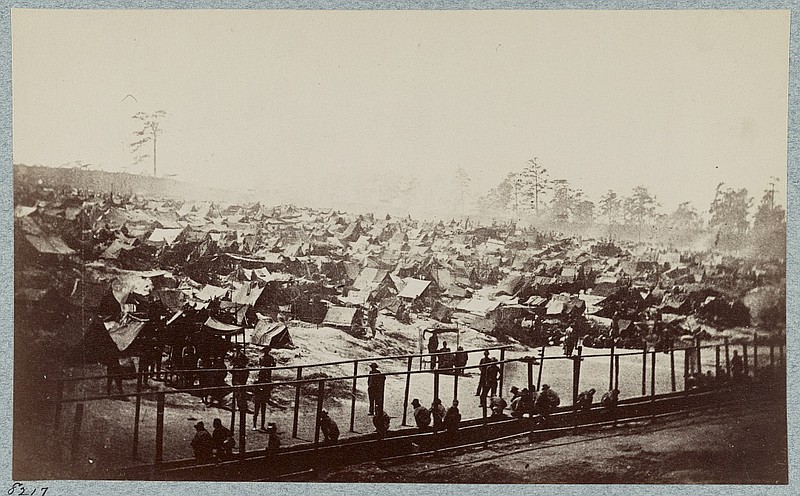During the course of the Civil War, 56,000 men died in confinement as prisoners of war. Before the war, the American military had no experience holding masses of prisoners. Accordingly, prisoners suffered not so much from intentional neglect as from their captors' ignorance and lack of experience. Many succumbed to illness brought about by inadequate nutrition, clothing and shelter.
Northern prisons were located at such frosty places as Rock Island, Ill.; Camp Douglas, near Chicago; Camp Chase, near Columbus, Ohio; and Elmira, in northern New York. Elmira's prisoners suffered a 25 percent mortality rate.
The most notorious Civil War prison was the Confederate facility at Andersonville (more properly, Camp Sumter), where 29 percent of its prisoners died. The prison contained at its peak nearly 33,000 men, crammed without adequate shelter into 26.5 acres of South Georgia mud without even the most rudimentary sanitation facilities. It was there that several unlucky men from Hamilton County, Tenn., found themselves in 1864.
These men were members of Company I of the 2nd Tennessee (U.S.) Infantry, which was formed in Sale Creek, north Hamilton County, in late 1861 and mustered into Federal service in Kentucky in early 1862. The 2nd Tennessee served primarily in Kentucky and East Tennessee north of Knoxville. Started as an infantry unit, it eventually became mounted infantry.
While camped at Rogersville in Hawkins County, Tenn., on Nov. 6, 1863, a Confederate assault overran the 2nd Tennessee and the 7th Ohio Cavalry. More than 400 Tennesseans were captured. The prisoners were first sent to the Confederate prison at Belle Isle, near Richmond, Va., and then in February 1864 to Andersonville.
An online list of Hamilton County Civil War soldiers compiled by John Wilson and the late Dr. Nat Hughes identifies eight members of Company I, 2nd Tennessee, from Hamilton County as imprisoned at Andersonville. Henry Hixson, a 26-year old farmer, and two brothers, who were probably his cousins, farmers Samuel Hixson and James M. Hixson, all died at Andersonville. Suffering from poor sanitary conditions, Henry died on May 11, 1864, of dysentery, Samuel died of the same illness at age 32 on Sept. 11. James died at age 26 of an unspecified ailment on Aug. 14.
When he enlisted at age 27, James N. Levi of Harrison was married with two young children. Captured with his comrades at Rogersville, Levi died at Andersonville on June 3, 1864, of smallpox. Alfred Vandegriff, a farm laborer with a wife and two children, enlisted at age 31 or 32. He died at Andersonville on Aug. 1 of unknown causes.
In February 1862, 42-year-old farmer Michael Weese of Soddy enlisted in the 2nd Tennessee with William, his 18-year-old son from his first marriage. His wife, Jemima, endured threats from Rebels on account of her husband's service for the Union. Michael happened to be at home on leave in early October 1863, when forage trains from the Federal army came to Soddy to gather food for the beleaguered forces in Chattanooga. The soldiers took 175 bushels of corn from Jemima's fields. Although Jemima eventually received some compensation, inadequate as it was, for her corn, she was left with little to feed her children during the winter.
Michael returned to his regiment. He and William were captured at Rogersville a month later. The privation of Andersonville took Michael first, who succumbed to pneumonia on April 4, 1864. William outlived his father by slightly over two weeks, dying of smallpox on April 23.
Hamilton County's lone Andersonville survivor, William M. Williamson, is shrouded in mystery. A farm laborer from the Long Savannah area (near today's Savannah Bay), Williamson was 23 or 24 when he enlisted in the Union Army at Sale Creek. Captured at Rogersville, he endured the terrible conditions of Andersonville and apparently another Rebel prison at Millen, Ga. He was back inside U.S. lines at Charleston, S.C., on Dec. 6. From there, Williamson went to "Camp Parole," Annapolis, Md.
He received a furlough to come to Chattanooga in early 1865 and was mustered out in March. Subsequently, Williamson and his family disappeared from local records, although he appears to have applied for a pension in 1869.
Sam D. Elliott is a local attorney with Gearhiser, Peters, Elliott and Cannon, chairman of the Tennessee Historical Commission and the author or editor of several books and essays on the Civil War. For more information, visit Chattahistoricalassoc.org or call LaVonne Jolley at 423-886-2090.
